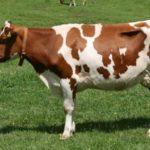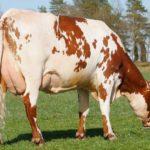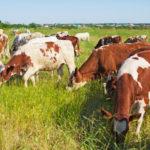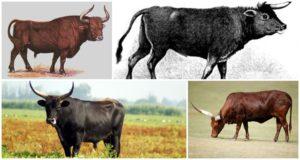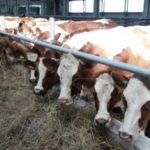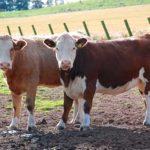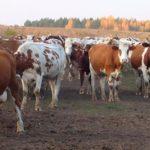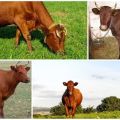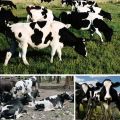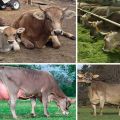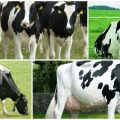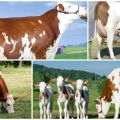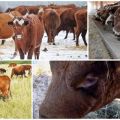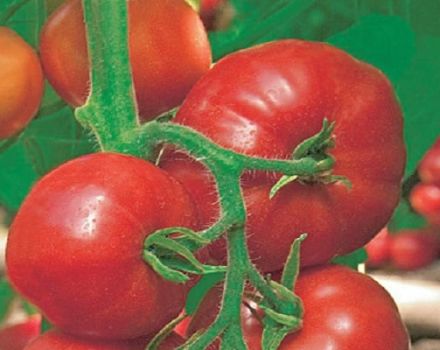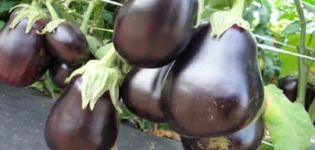Description and characteristics of red-and-white cows, their content
The youngest agricultural breeds of milk producing animals are represented by red-and-white cows. They were the result of crossing the Simmental and Red-and-White Holstein breeds. The purpose of breeding a breed is to enhance the characteristics of each representative. The breed was officially entered into the studbook in 1998. Breeding work is ongoing.
Origin
As an independent species, the red-and-white cow has existed for a little over 20 years. To improve the performance of each breed, geneticists-breeders have crossed Simmental bulls with Holstein cows for 20 years, constantly improving and consolidating the result obtained.
Officially red-and-white cows were recognized in 1998, which was confirmed by the inclusion of the breed in the herd book. This breed is very popular with both amateur farmers and large farms.
Appearance and productivity of the red-and-white breed
Characteristics of the breed:
| Horns | Short |
| Head | Massive |
| Rib cage | Deep and wide |
| Torso | Long, in proportion to the rest of the body |
| Muscle corset | Practically undeveloped |
| Skeletal system | Strong, wide |
| Coat | Short, shiny, color - bright red |
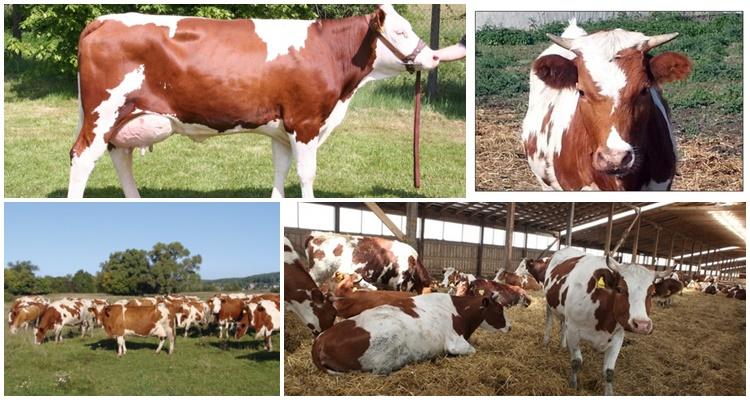
Although the color is called red, the natural color is brown, over which large white spots are unevenly distributed. The weight of an adult cow reaches 700 kg. The height at the withers at 2-3 years is 142-146 cm. The animals are muscled rather weakly, but the existing muscles are strong and elastic. This is worth paying attention to when choosing and purchasing livestock.
The red-and-white breed is valued not only as a dairy breed, but also as a meat one. The yield of beef from a young bull is 55.8%, from a cow - 54%. In order to obtain such values, it is necessary to correctly formulate a diet for cows and adjust it from time to time.
Advantages and disadvantages
The Holstein red-and-white breed has a large number of advantages:
- High milk yield with the right diet.
- Long reproductive period.
- Animals quickly adapt to any climatic conditions.
- Young individuals develop rapidly.
- Cattle are unpretentious in food.
- The udder of most of this species is cup-shaped, which is most optimal for manual and mechanical milking.
The red-and-white breed of cows has no disadvantages.
The subtleties of keeping and caring for animals
The level of care and conditions of detention directly affect such an indicator as milk yield. In order for the cows to feel as comfortable as possible, it is necessary to take into account the seasonal characteristics of the housing.
Summer playground
For the summer period, animals must be provided with round-the-clock walking. For this, a fenced enclosure or section of a field is suitable. Its size should be calculated based on the number of cows in the herd - at least 22 square meters should be allocated per head. m. A shelter must be installed in which animals can hide from strong winds, rainstorms or the scorching sun. There should be water and special feeders in the public domain.
Room arrangement
The barn room must be made of bricks. In order to keep it at a comfortable temperature in winter, it is necessary to take care of insulation and protect it from drafts. The room must be treated with special fire-fighting agents. The floors are lined with wood. Ventilation must ensure constant air circulation inside the room.
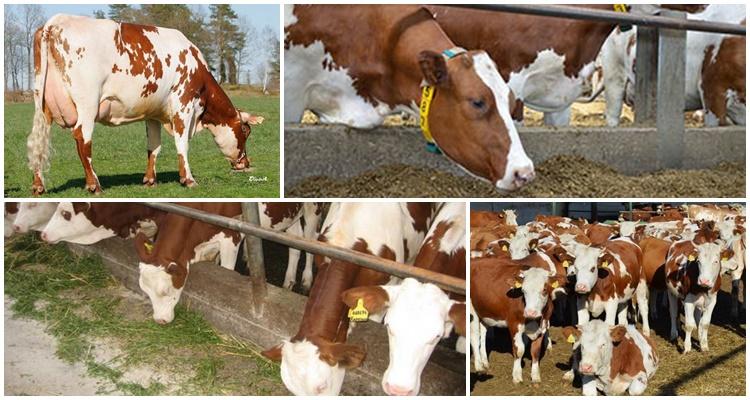
Conditions of detention
The air temperature in the barn should fluctuate within + 7 ... + 21 degrees, the air humidity should not exceed 65%. If, in the warm season, the ambient temperature rises above the upper value, the milk yield of livestock may decrease.
For good productivity, animals must have a long daylight hours. This can be achieved thanks to large windows and working artificial lighting.
Regular cleaning of the stall and equipment
Cow stalls should be cleaned twice a day - early in the morning and late in the evening. Individual buckets, drinkers and plastic feeders should be carefully handled to remove food debris and other contaminants. The litter is partially replaced once a week, and once a month it is renewed to zero. General cleaning of the premises with the use of disinfectants is carried out every six months.
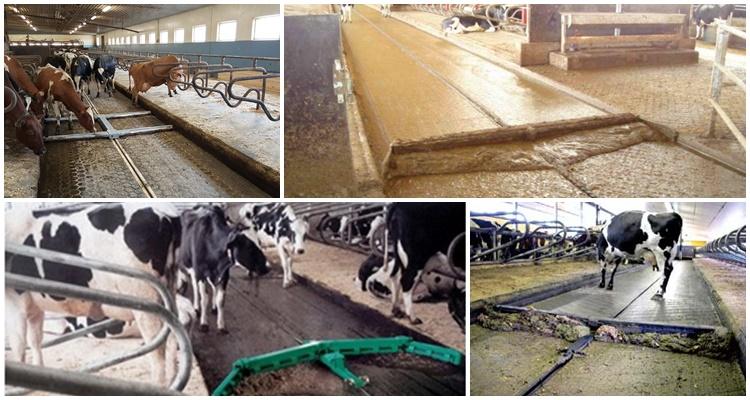
Preparing for milking
Before milking, you need to prepare both the place of the animal and the cow itself. All dirt must be removed from the stall, if necessary, fill up the bedding. After that, you need to perform a massage - brush away dust and dirt from the cow, take away and fix the tail, wipe the udder with warm water and a clean cloth, dry and thoroughly massage all the slices.
It is very important that the milking person's hands and clothes are clean and smell good.
Drawing up a diet
Nutrition depends on several factors - the season, the region of residence of the cows, the age of the cow and her period of life.
Summer
In summer, preference is given to succulent green food. 1 adult animal must have at least 8 kg of herbs and 13 kg of beets. Melons are included in the diet. On average, 1 adult cow eats about 80 centners of feed per year. It is important to ensure that cows go out to green pasture well fed. Eating grass greedily can cause bloating, diarrhea, and colic.
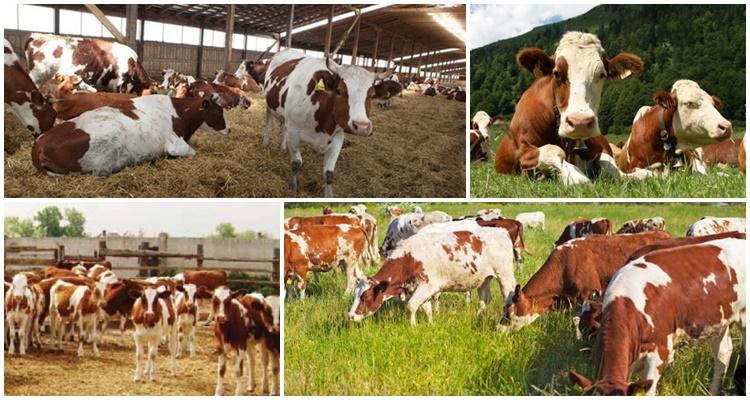
In winter
In winter, cattle should receive the following types of feed: succulent, rough, concentrates. There are about 1.8 kg of feed per 100 kg of live weight. During the day, the cow should receive wheatgrass hay, forbs, silage and haylage, feed for milk production. It is very important to ensure that the feeding schedule does not change. Deviations from it are permissible within 8-12 minutes. Disruption to your meal schedule can drastically reduce your milk supply.
Water
1 adult should drink at least 45 liters of clean water per day. If a cow is a cow, this figure is doubled. Cold water can cause stomach and intestinal problems, so the water is warmed up to room temperature before drinking.
Breeding nuances
The ripening period for cows lasts from 12 to 15 months. After that, offspring can be obtained from them for 12-14 years. The weight of the animal must be at least 320 kg, otherwise the offspring will be weak and will not survive.
The heat in cows of red-and-white breed occurs once every three weeks. In winter, it lasts 8-10 hours, in summer months - 11-12. If it becomes necessary to resort to artificial insemination, it must be carried out twice - directly into estrus and 10 hours after its end.
Diseases, their prevention and treatment
The main problem faced by farmers dealing with red-and-white cows is udder diseases. This is especially common during calving. The cow's udder is swollen, hyperemic, its temperature is slightly higher than the general temperature of the animal.
Cracks resulting from improper animal care and violation of milking technology are treated with special fatty creams, for example, "Burenka", "Zorka".
If the stall of the animal is poorly or rarely cleaned, pathogenic microorganisms accumulate in the litter, which provoke inflammation and numerous boils. It is necessary to process them with an alcohol solution of iodine and ASD 3 fractions in a dilution of 1: 4.
